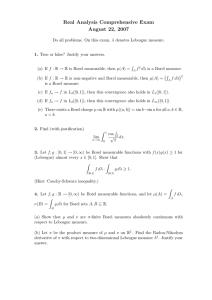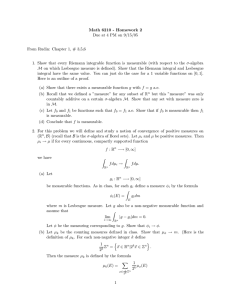221 Analysis 2, 2008–09 Suggested solutions to exercise sheet 3
advertisement
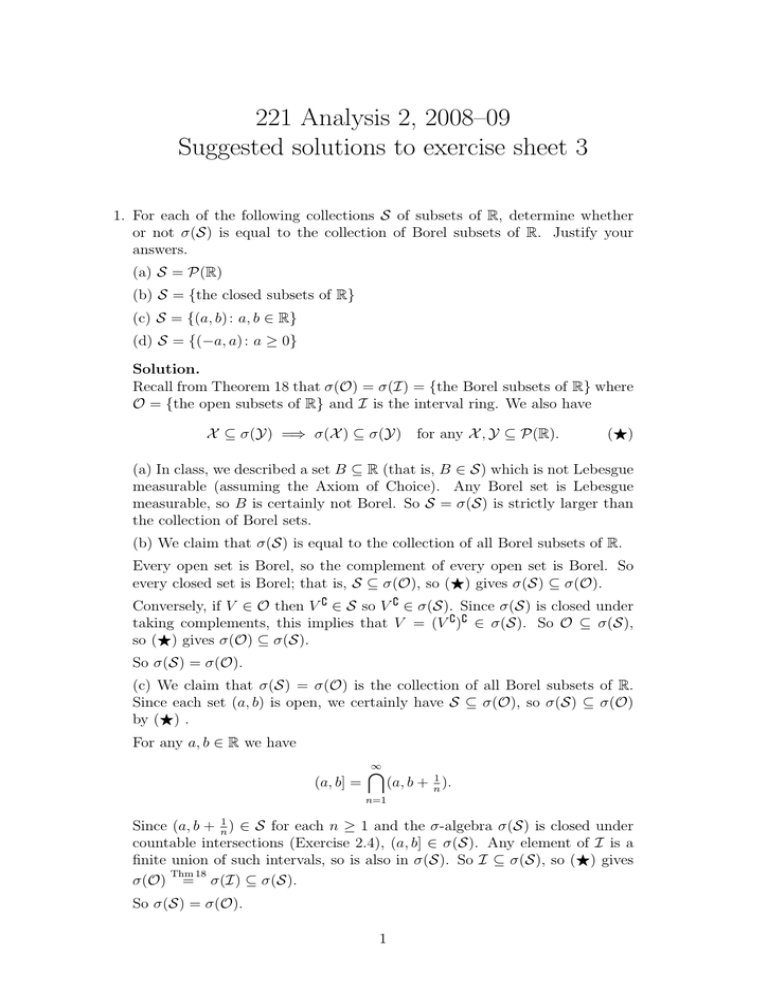
221 Analysis 2, 2008–09
Suggested solutions to exercise sheet 3
1. For each of the following collections S of subsets of R, determine whether
or not σ(S) is equal to the collection of Borel subsets of R. Justify your
answers.
(a) S = P(R)
(b) S = {the closed subsets of R}
(c) S = {(a, b) : a, b ∈ R}
(d) S = {(−a, a) : a ≥ 0}
Solution.
Recall from Theorem 18 that σ(O) = σ(I) = {the Borel subsets of R} where
O = {the open subsets of R} and I is the interval ring. We also have
X ⊆ σ(Y) =⇒ σ(X ) ⊆ σ(Y) for any X , Y ⊆ P(R).
(F)
(a) In class, we described a set B ⊆ R (that is, B ∈ S) which is not Lebesgue
measurable (assuming the Axiom of Choice). Any Borel set is Lebesgue
measurable, so B is certainly not Borel. So S = σ(S) is strictly larger than
the collection of Borel sets.
(b) We claim that σ(S) is equal to the collection of all Borel subsets of R.
Every open set is Borel, so the complement of every open set is Borel. So
every closed set is Borel; that is, S ⊆ σ(O), so (F) gives σ(S) ⊆ σ(O).
Conversely, if V ∈ O then V { ∈ S so V { ∈ σ(S). Since σ(S) is closed under
taking complements, this implies that V = (V { ){ ∈ σ(S). So O ⊆ σ(S),
so (F) gives σ(O) ⊆ σ(S).
So σ(S) = σ(O).
(c) We claim that σ(S) = σ(O) is the collection of all Borel subsets of R.
Since each set (a, b) is open, we certainly have S ⊆ σ(O), so σ(S) ⊆ σ(O)
by (F) .
For any a, b ∈ R we have
(a, b] =
∞
\
(a, b + n1 ).
n=1
Since (a, b + n1 ) ∈ S for each n ≥ 1 and the σ-algebra σ(S) is closed under
countable intersections (Exercise 2.4), (a, b] ∈ σ(S). Any element of I is a
finite union of such intervals, so is also in σ(S). So I ⊆ σ(S), so (F) gives
Thm 18
σ(O) = σ(I) ⊆ σ(S).
So σ(S) = σ(O).
1
(d) In this case, σ(S) 6= σ(O). To see this, let us call a set A ⊆ R symmetric
if x ∈ A ⇐⇒ −x ∈ A, and let A be the collection of symmetric Borel sets:
A = {A ∈ σ(O) : x ∈ A ⇐⇒ −x ∈ A}.
Now A is a σ-algebra, since: (i) the empty set is in A; (ii) the complement of a
Borel symmetric set A is Borel and symmetric (since x 6∈ A ⇐⇒ −x 6∈ A),
so ASis closed under taking complements; and (iii) if A1 , A2 , · · · ∈ A and
A= ∞
n=1 An then A is Borel and is also symmetric since
x ∈ A ⇐⇒ x ∈ An for some n ≥ 1
⇐⇒ −x ∈ An for some n ≥ 1 ⇐⇒ −x ∈ A;
so A ∈ A.
Clearly S ⊆ A, and A = σ(A) since A is a σ-algebra. So (F) gives σ(S) ⊆ A.
Now (0, 2) is a Borel set but is not symmetric, so is not in A. So (0, 2) 6∈ σ(S),
so σ(S) 6= σ(O).
2. Let (X, M, m) be a measure space. Show that if f : X → [−∞, ∞] is a
measurable function then A = {A ⊆ R : f −1 (A) ∈ M} is a σ-algebra which
contains every Borel set.
[As usual, f −1 (A) = {x ∈ X : f (x) ∈ A}.]
Solution. Recall that for any sets A, A1 , A2 , . . . ,
f −1 (A{ ) = {x ∈ X : f (x) 6∈ A} = {x ∈ X : f (x) ∈ A}{ = f −1 (A){
and
f
−1
(
∞
[
An ) = {x ∈ X : f (x) ∈ An for some n ≥ 1} =
n=1
∞
[
f −1 (An ).
n=1
To check that A is a σ-algebra:
(i) Since f −1 (∅) = ∅ ∈ M, we have ∅ ∈ A.
(ii) If A ∈ A then f −1 (A) ∈ M so f −1 (A{ ) = f −1 (A){ ∈ M. So A{ ∈ A.
(iii) If A1 , A2 , · · · ∈ A then f −1 (An ) ∈ M for all n ≥ 1, so
f −1 (
∞
[
n=1
So
S∞
n=1
An ) =
∞
[
f −1 (An ) ∈ M.
n=1
An ∈ A.
So A is a σ-algebra, so A = σ(A). Since f is measurable, we know that
(α, ∞] ∈ A for all α ∈ R. Since A is a σ-algebra it is closed under set
differences, so (α, β] = (α, ∞] \ (β, ∞] ∈ A for all α, β ∈ R. So (taking finite
unions) we see that I ⊆ A; so {Borel subsets of R}
Thm 18
=
(F)
σ(I) ⊆ A.
3. Let (X, M, m) be a measure space and for A ⊆ X, let χA : X → [0, ∞) be
the characteristic function of the set A.
(a) Show that χA is measurable if and only if A ∈ M.
(b) Show that χA{ = 1−χA . [This means: χA{ (x) = 1−χA (x) for all x ∈ X.]
(c) Show that if A, B ⊆ X then χA χB = χA∩B .
(d) Find an expression for χA∪B in terms of χA and χB .
2
Solution. (a) For α ∈ R, we have
∅
−1
χA (α, ∞] = {x ∈ X : χA (x) > α} = A
X
if α ≥ 1
if 0 ≤ α < 1
if α < 0.
Since M is a σ-algebra, both ∅ and X = ∅{ are in M. So χA is measurable
⇐⇒ χ−1
A (α, ∞] ∈ M for all α ∈ R ⇐⇒ A ∈ M.
(b) We have
(
1
χA{ (x) =
0
if x ∈ A{
if x ∈ A
(
1−0=1
and 1 − χA (x) =
1−1=0
if x ∈ A{
if x ∈ A.
So χA{ = 1 − χA .
(c) If x ∈ A ∩ B then χA∩B (x) = 1 and χA χB (x) = χA (x)χB (x) = 1 · 1 = 1.
If x ∈ (A ∩ B){ = A{ ∪ B { then χA∩B (x) = 0, and at least one of χA (x) and
χB (x) is zero; so χA χB (x) = χA (x)χB (x) = 0. So χA∩B (x) = χA χB (x) for
every x ∈ X; so χA∩B = χA χB .
(d) We have A ∪ B = (A{ ∩ B { ){ . So
χA∪B = 1 − χA{ ∩B {
= 1 − χ A{ χ B {
= 1 − (1 − χA )(1 − χB )
= χA + χB − χA χB .
Other expressions include: χA∪B = max{χA , χB } =
by (b)
by (c)
by (b)
χA +χB
.
1+χA χB
4. Let X be a non-empty set and let ϕ : X → R be a simple function; that is,
ϕ(X) is a finite set.
(a) Show that if ϕ(X) = {a1 , . . . , an } where ai 6= aj for i 6= j and if we define
Ai = ϕ−1 (ai ) then A1 ∪ · · · ∪ An is a partition of X into (non-empty) subsets,
and
ϕ = a1 χA1 + · · · + an χAn .
(∗)
(b) Show that if m ≥ 1 and b1 , . . . , bm are any distinct real numbers and
B1 ∪ · · · ∪ Bm is a partition of X into (non-empty) subsets with
ϕ = b1 χB1 + · · · + bm χBm ,
then n = m and there is a permutation π ∈ Sn with bi = aπ(i) and Bi = Aπ(i)
for each i = 1, 2, . . . , n.
(c) If (X, M, m) is a measure space, show that ϕ is a measurable function if
and only if ϕ can be written in the form (∗) for some A1 , A2 , . . . , An in M.
3
Solution. We have ϕ(X) = {a1 , . . . , an } = {a1 } ∪ · · · ∪ {an }, so
X = ϕ−1 ({a1 } ∪ · · · ∪ {an }) = ϕ−1 (a1 ) ∪ · · · ∪ ϕ−1 (an ) = A1 ∪ · · · ∪ An ,
and if i 6= j then ai 6= aj so {ai } ∩ {aj } = ∅ and
Ai ∩ Aj = ϕ−1 (ai ) ∩ ϕ−1 (aj ) = ϕ−1 ({ai } ∩ {aj }) = ϕ−1 (∅) = ∅.
Moreover, for each i ∈ {1, 2, . . . , n}, the number ai is in the range of ϕ, so
for some x ∈ X we have ϕ(x) = ai ; so x ∈ Ai and Ai is non-empty.
If x ∈ Ai then ϕ(x) = ai and for i 6= j we have Ai ∩ Aj = ∅, so x 6∈ Aj . So
χAj (x) = 0. Hence
(a1 χA1 + · · · + an χAn )(x) = 0 + · · · + 0 + ai χAi (x) + 0 + · · · + 0 = ai = ϕ(x).
So a1 χA1 + · · · + an χAn = ϕ.
(b) Since {Bj }m
j=1 form a partition of X into non-empty subsets, we have
ϕ(X) = {b1 , . . . , bm } and this is also {a1 , . . . , an }. Since bi 6= bj for i 6= j,
we must have n = m, and (b1 , . . . , bn ) is a permutation of (a1 , . . . , an ), say
bi = aπ(i) for some π ∈ Sn .
We have to show that Bi = Aπ(i) ; but if x ∈ Bi then x ∈ Aπ(j) for some j,
so ϕ(x) = bi = aπ(j) = aπ(i) . So π(i) = π(j), so i = j and Bi ⊆ Aπ(i) . Since
B1 ∪ · · · ∪ Bn = A1 ∪ · · · ∪ An = X, this gives Aπ(i) = Bi .
(c) If ϕ is a measurable function then by Exercise 2, ϕ−1 (B) is measurable for
any Borel subset of R. Since {ai } is a Borel subset of R (by Exercise 2.5(a)),
we see that ϕ−1 ({ai }) = Ai is a measurable set.
Conversely, if A1 , . . . , An are measurable then, since
[
ϕ−1 (α, ∞] = {x ∈ X : ϕ(x) > α} = {x ∈ X : x ∈ Ai , ai > α} =
Ai ,
{i : ai >α}
we see that ϕ−1 (α, ∞] is a (finite) union of measurable sets, so is measurable.
5. Let (X, M, m) be a measure space and let A ∈ M. Show that for every
measurable function f : X → [−∞, ∞], the function f χA : X → [−∞, ∞],
x 7→ f (x)χA (x) is also measurable.
Solution. For α ∈ R, we have
(f χA )−1 (α, ∞] = {x ∈ X : f (x)χA (x) > α}
= {x ∈ A : f (x) > α} ∪ {x ∈ A{ : 0 > α}
(
A ∩ f −1 (α, ∞]
if α ≥ 0
=
−1
{
(A ∩ f (α, ∞]) ∪ A if α < 0.
Since A ∈ M we also have A{ ∈ M, and since f is measurable we have
f −1 (α, ∞] ∈ M. So whether α ≥ 0 or α < 0, we have (f χA )−1 (α, ∞] ∈ M
(using the fact that M is closed under [finite] intersections and unions). So
f χA is measurable.
4
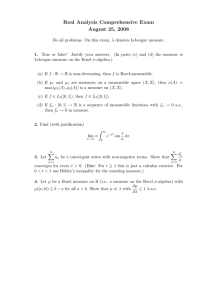
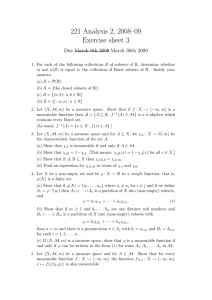
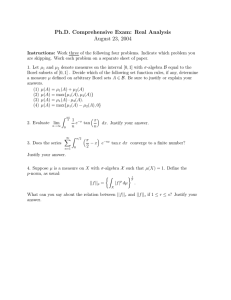
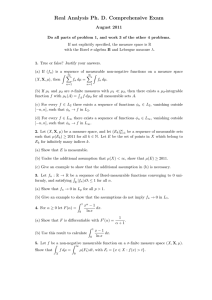

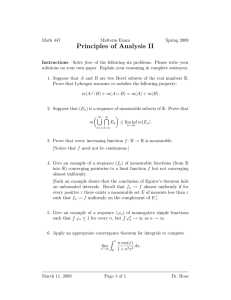
![MA2224 (Lebesgue integral) Tutorial sheet 5 [February 19, 2016] Name: Solutions](http://s2.studylib.net/store/data/010730672_1-a892ada8d0a07e1c5cf78400ac6d42a7-300x300.png)
